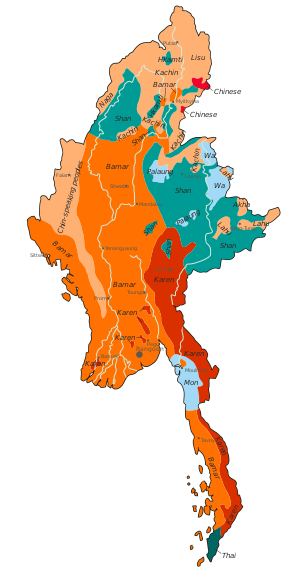Languages of Myanmar
| Languages of Myanmar (Burma) | |
|---|---|
Austroasiatic and Indo-Aryan languages | |
| Foreign | English, Mandarin Chinese |
| Signed | Burmese sign language |
| Keyboard layout | |

There are approximately a hundred languages spoken in Myanmar (also known as Burma).[1] Burmese, spoken by two-thirds of the population, is the official language.[2]
Languages spoken by ethnic minorities represent six
Burmese
Burmese is the native language of the Bamar people and related sub-ethnic groups of the Bamar, as well as that of some ethnic minorities in Burma like the Mon. In 2007, Burmese was spoken by 33 million people as a first language.[5] Burmese is spoken as a second language by another 10 million people, particularly ethnic minorities in Burma and those in neighbouring countries.[6]
Burmese is a
As far as
Indigenous languages
Aside from Myanmar (Burmese) and its dialects, the hundred or so languages of Myanmar include
Most of these languages use the Myanmar (Burmese) script.In Myanmar, usage of its minority languages is discouraged.[9]
It is not clear if there are one or two Burmese sign languages.[citation needed]
Sino-Tibetan
- Languages in Chin State
- Other
- Akeu
- Akha
- Anal
- Nung
- Sak
- Derung
- Hpon
- Kadu
- Ganan
- Kayaw
- Red Karen
- Padaung
- Kayaw
- Lashi
- Lahta
- Lahu
- Lhao Vo
- Lisu
- Mru
- Mro
- Akyaung Ari
- Kayaw
- Eastern Pwo
- Western Pwo
- Para
- Khiamniungan
- Koki
- Konyak
- Leinong
- Tangsa
- Long Phuri
- Makury
- Ponyo
- Tangkhul
- Tangsa
- Achang
- Nusu
- Pa'o
- Pyen
- Arakanese
- Rawang
- Riang
- Taman
- Khams Tibetan
- Geko Karen
- Zaiwa
- Zou
- Intha-Danu
Austroasiatic
Kra-Dai
Austronesian
- Kedah Malay
- Moken
- Moklen
- Salone
- Standard Malay
Hmong-Mien
Indo-Aryan
Dravidian
English as a second language

Today, Burmese is the primary language of instruction, and English is the secondary language taught.[9] English was the primary language of instruction in higher education from late 19th century to 1964, when Gen. Ne Win mandated educational reforms to "Burmanise".[10] English continues to be used by educated urbanites and the national government.
See also
- Burmese English
Footnotes
- ^ a b Goddard 2005
- ^ Burmese at Ethnologue (25th ed., 2022)

- ^ a b Myanmar in Eberhard, David M.; Simons, Gary F.; Fennig, Charles D., eds. (2022). Ethnologue: Languages of the World (25th ed.). Dallas, Texas: SIL International.
- ^ Mathur & Napoli, 2010, Deaf around the World: The Impact of Language
- ^ Mikael Parkvall, "Världens 100 största språk 2007" (The World's 100 Largest Languages in 2007), in Nationalencyklopedin
- ^ Burmese at Ethnologue (25th ed., 2022)

- ^ a b Bradley 1993, p. 147.
- ^ a b Saini 2016, p. 1.
- ^ a b Lintner 2003, p. 189
- ^ Thein 2004, p. 16
References
- Saini, Jatinderkumar R. (30 June 2016). "First Classified Annotated Bibliography of NLP Tasks in the Burmese Language of Myanmar". Revista InforComp (INFOCOMP Journal of Computer Science). 15 (1). Lavras, MG, Brazil: University of Lavras: 1–11.
- Bradley, David (Spring 1993). "Pronouns in Burmese–Lolo" (PDF). Linguistics of the Tibeto-Burman Area. 16 (1). Melbourne: La Trobe University.
Bibliography
- ISBN 0-19-924860-5
- Myanmar in Eberhard, David M.; Simons, Gary F.; Fennig, Charles D., eds. (2022). Ethnologue: Languages of the World (25th ed.). Dallas, Texas: SIL International.
- ISBN 0-415-25816-2
- Thein, Myat (2004), Economic Development of Myanmar, Institute of Southeast Asian Studies, ISBN 981-230-211-5

